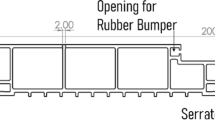Abstract
The orientation in which parts are held during the quenching operation can have a strong effect on the overall success of heat treating. Certain orientations can result in significantly greater distortion than other orientations, even when high-quality quenchants are used. In this study, various simple, rolled ring geometries are examined at two different orientations to quenchant flow using computational fluid dynamics with the software program AZORE®. These parts were examined singly without the influence of other parts in close proximity. Three rolled ring geometries were examined, using the same outside diameter, while the inside diameter was varied. These flow fields will be used for understanding the likely distortion occurring during quenching.













Similar content being viewed by others
References
Azore® Technologies, LLC, Azore ® Users Guide, 2011
J.D. Franklin and J.S. Lee, Momentum/Continuity Coupling with Large Non-Isotropic Momentum Source Terms, Int. J. Numer. Methods Fluids, 2009, 61, p 946–969
J.H. Ferziger and H. Peric, Computational Methods for Fluid Dynamics, Springer, New York, 1997
Deformation Control Technology, Inc., DANTE Users Manual, 2011
Acknowledgments
The authors gratefully acknowledge the support of their companies for this study. Helpful discussions with their colleagues are also gratefully acknowledged.
Author information
Authors and Affiliations
Corresponding author
Additional information
This article is an invited paper selected from presentations at the 26th ASM Heat Treating Society Conference, held October 31 through November 2, 2011, in Cincinnati, Ohio, and has been expanded from the original presentation.
Rights and permissions
About this article
Cite this article
Banka, A.L., Ferguson, B.L. & MacKenzie, D.S. Evaluation of Flow Fields and Orientation Effects Around Ring Geometries During Quenching. J. of Materi Eng and Perform 22, 1816–1825 (2013). https://doi.org/10.1007/s11665-013-0509-z
Received:
Revised:
Published:
Issue Date:
DOI: https://doi.org/10.1007/s11665-013-0509-z




